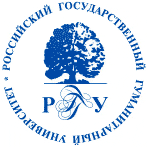Russian State University for the Humanities
The Russian State University for the Humanities (RSUH, RGGU; Russian: Росси́йский госуда́рственный гуманита́рный университе́т, РГГУ, romanized: Rossijskij gosudarstvennyj gumanitarnyj universitet, RGGU), is a university in Moscow, Russia with over 14,000 students. It was created in 1991 as the result of the merger of the Moscow Public University (est. 1908) and the Moscow State Institute for History and Archives (est. 1930). The institute occupies a network of historic buildings along the Nikolskaya Street in Kitay-gorod, including the former Moscow Print Yard and the cells of the Zaikonospassky monastery.
Российский государственный гуманитарный университет | |
 Logo of RSUH | |
Former names | Moscow Public University (1908–1918), Moscow State Institute for History and Archives (1930–1990) |
|---|---|
| Motto | Вековые традиции — современные технологии (Russian) |
Motto in English | Centuries-old Tradition, Contemporary Technology |
| Type | Public |
| Established | 1991 |
| President | Yefim Iosifovich Pivovar |
| Provost | Valery Vladmirovich Minayev |
| Rector | Alexander Bezborodov |
| Students | 5,500 |
| Location | , |
| Campus | Urban |
| Nickname | RSUH, RGGU |
| Website | rggu.com |
History
The Moscow Public University was founded in 1908 on the initiative of the eminent Russian patron of the arts, Alfons Shanyavsky, and played a special role in Russian higher education from its inception. It was the center of enlightened and moral education right up to 1918, realizing the progressive principles of alternative education in conjunction with a sound educational foundation available to all.
The Moscow State Institute for History and Archives, founded in 1930 as a center for the preparation of archivists, became over the years a focus of scientific research. In its archival pursuits in areas of history and such auxiliary realms as the study of primary sources, archaeology and palaeography, it managed to preserve the very best of Russian research. By the beginning of the 1990s, this institution had achieved university level which naturally enabled it to become the organizational heart of the RSUH, founded in 1991.
RSUH currently comprises seven institutes, eleven faculties, nineteen scientific and educational centers, eight laboratories, and fifty departments. Its principal subdivisions are as follows:
- Faculty of History, Political Science, and Law (including the Center for Oriental Studies)
- Archives School
- Institute of European Cultures
- Marc Bloch Russian-French Centre for Historical Anthropology
- Faculty of Philosophy (including the Department of Sociology)
- History of Art Faculty
- Historical-Philological Faculty
- Institute of Information Sciences and Security Technologies
- Institute of Mass Media
- Institute of Linguistics (including the Department of Linguistics, and the Department of Intellectual Systems).
- L. S. Vygotsky Institute of Psychology
- Institute of Economics, Management and Law (including the Faculty of Management, the Faculty of Economics, and the Faculty of Law).
Its curriculum extends from preparatory to post-doctoral studies. The university is most renowned for its linguistics, intelligent systems (AI), cliometrics and cliodynamics research groups.
It also has many ties with universities abroad, including Université Laval, Trinity College, Helwan University and Cairo University.
- Main Building (Corpus 6)
 View of the RSUH campus
View of the RSUH campus
See also
External links
- (in Russian) Official university website
- (in English) Official university website